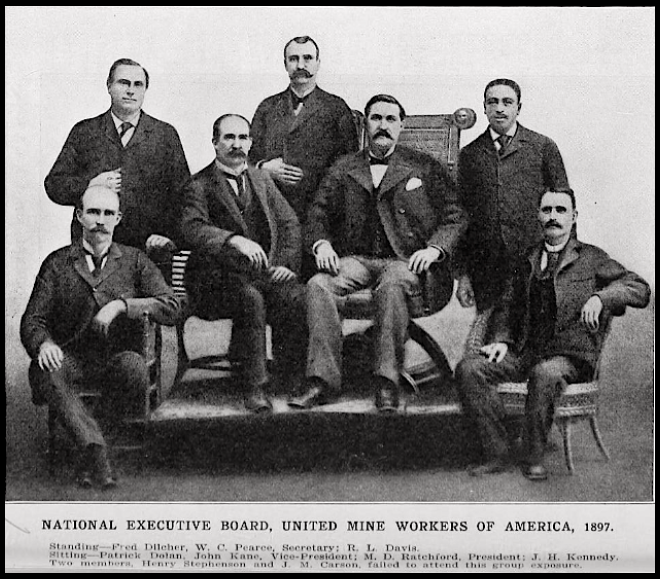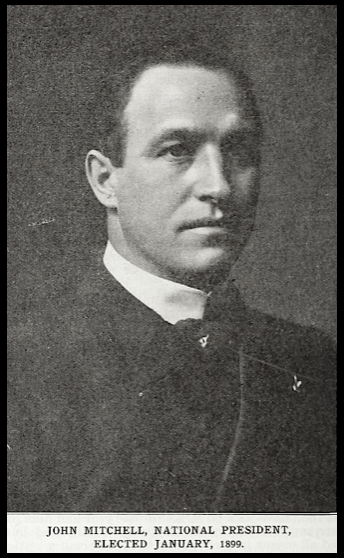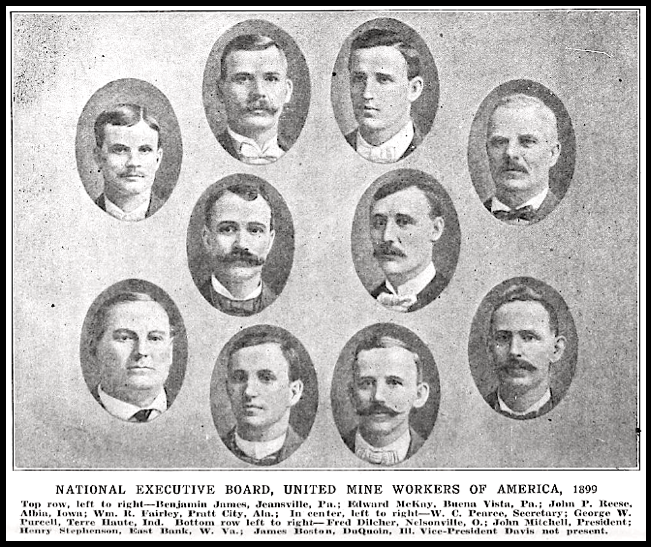 ———-
———-
Hellraisers Journal – Saturday March 18, 1899
United Mine Workers to Celebrate Eight-Hour Day Victory
From The American Federationist of March 1899:
Miners’ Eight-Hour Day.
—–
—–
An echo of the great victory of the miners in their strike of 1897, comes to us just now. It will be remembered that as a result of that memorable contest the miners secured, apart from an increase of 33 per cent, in wages, the establishment of the eight-hour day in the competitive field to be inaugurated April 1, 1898. After working under the eight-hour system for nearly a year the officers of the United Mine Workers through President Mitchell and Secretary Pearce have just issued the fallowing call upon the miners of the country:
Inasmuch as Saturday, April 1, 1899, marks the first anniversary of the inauguration of the eight-hour work day in the central competitive coal mining States, we desire that it be fittingly observed by members of our craft.
In commemorating this event, we not only can demonstrate our appreciation of the shorter work day, but also the re-establishment of joint movement methods of adjusting wage differences. When the Chicago agreement was entered into one year ago, which provided for the establishment of an eight-hour day in the States of Western Pennsylvania, Ohio, Indiana and Illinois, grave fears were entertained as to the probable outcome. That the influences it would exert over the trade of the States in question would be detrimental was freely argued by many, but we find, at this the close of the first year, that its adoption has not only proven a priceless boon to our craft, but also is looked upon with favor by many of our employers. The reaffirmation of the Chicago agreement by the Pittsburg convention means a continuation of these conditions and is a fitting endorsement of the policy. We therefore desire that Saturday, April 1, be set apart as a holiday to commemorate this important event and that local unions arrange suitable meetings, where appropriate exercises can be held. We further request our membership in States where the agreement is not operative at this time to likewise observe this day and thereby register your approval of this method and encourage its universal adoption.
—–
———-
[Emphasis and photographs added.]
~~~~~~~~~~~~~~~~~~~~~~
SOURCES
Quote Mother Jones, Brave Hearts, UMWC, Jan 29, 1909
https://play.google.com/books/reader?id=aiAtAQAAMAAJ&printsec=frontcover&pg=GBS.PA517
The American Federationist, Volume 6
(Washington, District of Columbia)
-Mar 1899 to Dec 1899
https://books.google.com/books?id=S0zuU-dHKTIC
Vol. VI, No. I-Mar 1899
https://play.google.com/books/reader?id=S0zuU-dHKTIC&hl=en&pg=GBS.PP7
“Miners’ Eight-Hour Day”
https://play.google.com/books/reader?id=S0zuU-dHKTIC&hl=en&pg=GBS.PA8
IMAGES
UMW Ex Brd 1897, Evans II p480
https://archive.org/details/historyofunitedm21evan/page/480
John Mitchell, Pres UMW Jan 1899, Evans II p650
https://archive.org/details/historyofunitedm21evan/page/650
UMW Ex Brd 1899, Evans II p764
https://archive.org/details/historyofunitedm21evan/page/764
See also;
Bituminous Coal Strike of 1897
https://www.encyclopedia.com/history/encyclopedias-almanacs-transcripts-and-maps/bituminous-coal-strike
Tag: Lattimer Massacre of 1897
https://weneverforget.org/tag/lattimer-massacre-of-1897/
For more on Strike of 1897:
United Mine Workers Journal of June 1, 1922
https://play.google.com/books/reader?id=ZnMtAQAAMAAJ&printsec=frontcover&pg=GBS.PT246
https://play.google.com/books/reader?id=ZnMtAQAAMAAJ&printsec=frontcover&pg=GBS.PT258
-John L. Lewis discusses 1897 strike and 1898 agreement for Central Competitive Field:
Stabilizing Force of the Union
Any one who, calmly and without passion, reviews the history of the coal mining industry in this country during the past 50 years is inevitably led to the conclusion that the mine workers’ union has been the one consistent stabilizing, constructive force…..
In the bituminous industry, the record of the union has been still more notable, because of the greater obstacles to be overcome. The conditions existing in the early days of bituminous mining were indescribably vicious. Because of rapid over-expansion in capital commitments and the resultant competition, labor received far less than a subsistence wage, and working under deplorable conditions, was bitterly resentful and discontented. Investment capital was unwilling to enter the industry, and as a result bituminous coal mining became largely a gambling, speculative enterprise.
The Joint Conference of 1898
The breaking point came, as it was bound to come sooner or later, in the year 1897, when the United Mine Workers called a strike. The organization was then young, having been established only in 1890, and having in 1897 a membership of not more than 10,000. The wretched condition of labor at the time is no where more strikingly shown than in the fact that some 150,000 men, practically the entire Central Field, responded to the strike call.
From this strike there resulted the joint conference and joint agreement of 1898. The districts represented were Ohio, Illinois, Indiana and Western Pennsylvania. The operators of West Virginia were invited, but did not respond.
The conditions leading up to this conference, and the resulting agreement of 1898, have already been suggested. Because of unrestricted competition in an overdeveloped industry, wages had fallen below even the subsistence level and profits had fallen below anything like an adequate return on the investment. The principal thing which both parties expected to gain from the agreement was the continuance of uniform and undisturbed labor conditions at least for the period of the contract. In addition labor was granted an 8-hour day, and a slight increase in wages. The operators derived no specific benefits other than those, which were of inestimable value to them, of industrial peace and substantial uniformity of labor conditions for all operators in the Central Competitive Field. All of these things were perfectly lawful and in accord with the best public policy.
The agreement of 1898 in the Central Competitive Field ran for one year. At its expiration a similar agreement for the succeeding year was negotiated. Thereafter, until the present time, successive agreements of this character have been negotiated for periods of one year or two years for the same groups of states, and, later. the same policy of joint agreements was extended to other fields, such as the Northwest and Southwest Fields. In every case, the idea was to establish substantial uniformity of labor conditions for the States or districts within the same competitive area.
[Emphasis added.]
For more on UMWA 1897-99:
History of United Mine Workers of America, Vols I & II
-by Chris Evans
Allied Printing Trades Council, Indianapolis, 1920
https://catalog.hathitrust.org/Record/101821370
Vol II – 1890 to 1900
https://babel.hathitrust.org/cgi/pt?id=dul1.ark:/13960/t6j14w86h;view=2up;seq=4
https://archive.org/details/historyofunitedm21evan/page/n4
1897 UMW History begins on page 435
https://archive.org/details/historyofunitedm21evan/page/434
1898 UMW History begins on page 509
https://archive.org/details/historyofunitedm21evan/page/508
1899 UMW History bigins on page 618
https://archive.org/details/historyofunitedm21evan/page/618
UMW Hx by Evans, Definitive Proof of Publication in 1920:
April 9, 1921 (for week ending this date)
–Industrial News Survey: “4th Annual Book Review”
“confined to books issued during the year 1920”
https://play.google.com/books/reader?id=7-5JAQAAMAAJ&hl=en&pg=GBS.PP62
page 24 -Review of Hx of UMWA by CE
https://play.google.com/books/reader?id=7-5JAQAAMAAJ&hl=en&pg=GBS.PA24
THE HISTORY OF UNITED MINE WORKERs of AMERICA, FROM THE YEAR 1860-1900, by Chris Evans. Published by Allied Printing Trades Council, Indianapolis, Ind. 2 v. 1349 pp. An official history of the growth, development and achievements of the largest trade union in America, the United Mine Workers of America, from 1860 to 1900. The proceedings of each of the annual meetings of the organization are reviewed in detail, and a rather thorough account, from the trade union viewpoint, of the development of collective agreements in the coal mining industry given.
~~~~~~~~~~~~~~~~~~~~~~~~~~~~~~~~~~~~~~~~~~~~~
Miners Life – Kilshannig



